In today's digital age, online promotion has become absolutely essential for businesses of all sizes. With 75% of consumers saying online ads allows them to easily find the product they are looking for, it is crucial for companies to have a strong online presence that effectively showcases their products or services.
By implementing effective digital marketing strategies, businesses can reap a multitude of benefits ranging from increased brand awareness to higher customer engagement.
That's why in this ultimate guide, we're going to explore the various ways in which you can promote your business online and unlock its full potential in the ever-expanding digital realm. With a trusted digital agency by your side, your business can surely take the online landscape by storm.
So, let's dive in and discover the power of online promotion!
How can I effectively promote my business online?
Establishing a robust online presence is no longer just an option—it's a necessity for businesses aiming to thrive in a competitive marketplace. This underscores the result of a marketing survey from Taradel where 94% of small businesses stated that they are planning boost their marketing budget in 2024.
However, with the vast array of digital marketing tactics available, where should businesses focus their efforts to achieve maximum impact? From search engine optimisation (SEO) and social media marketing to email campaigns and content creation, navigating the complex landscape of online promotion can be overwhelming.
In the following sections, we'll explore the most effective ways for promoting your business online, empowering you to reach your target audience, drive engagement, and ultimately, boost your bottom line.
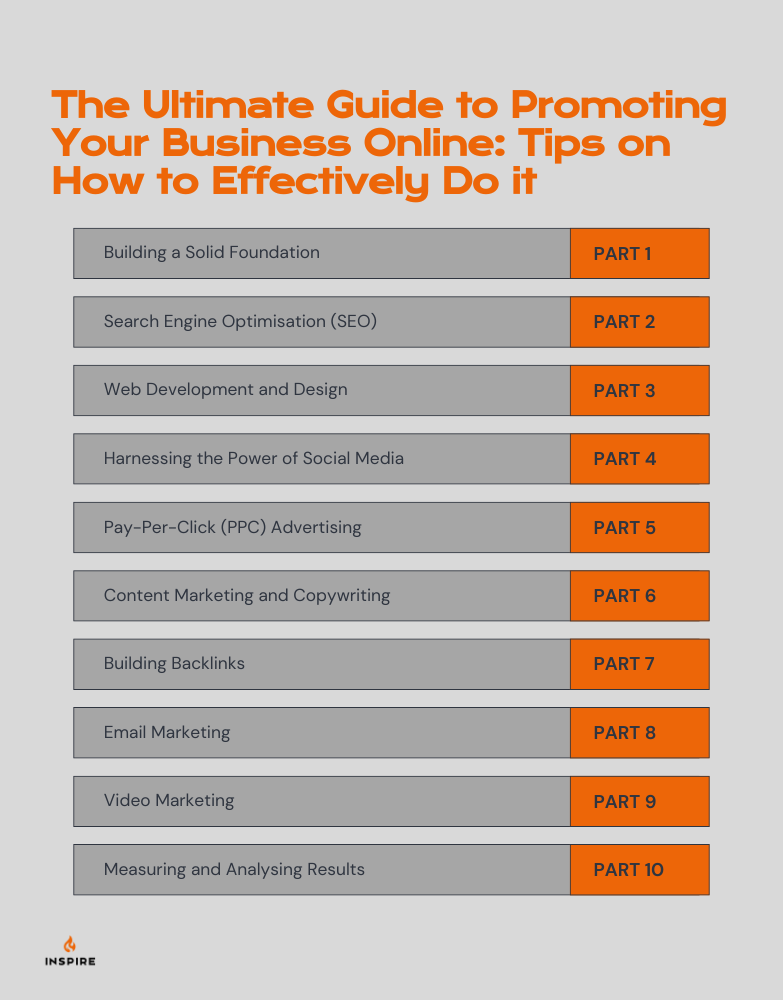
Part 1: Building a Solid Foundation
Before diving head first into the world of digital marketing, it's essential to lay down a solid foundation that will serve as the bedrock of your online promotion efforts. This foundation begins with a deep understanding of your target audience—the individuals who are at the heart of your business's success.
By comprehensively understanding the demographics, preferences, and behaviours of your target audience, you can tailor your marketing strategies to resonate with their needs and desires. But effective online promotion goes beyond just knowing your audience; it also involves setting clear goals and objectives that align with your overarching business objectives.
Let's explore the critical components of building a solid foundation for your digital marketing endeavors.
Understanding your target audience
Being aware of who you're trying to reach is a crucial step for your business to succeed. Understanding their needs, preferences, and behaviour is how you can stay relevant and on top of their minds when looking for a specific product or service related to your business.
But, before we begin discussing the steps of how to find and connect with your target audience, let's first define what it is.
So, what is a target audience?
A target audience is a specific group of consumers characterised by a particular behaviour and demographics who are most likely to buy your products or services.
On the other hard, target market is much broader, referring to a group of people who may be interested in your products of services while target personas go into detail of what a prospective customer looks like.
For example, if your target market is "web designers in the food industry", you target audience will be "web designers in the food industry based Glasgow".
Let's look at this table from Search Engine Journal to better understand the differences between the three:
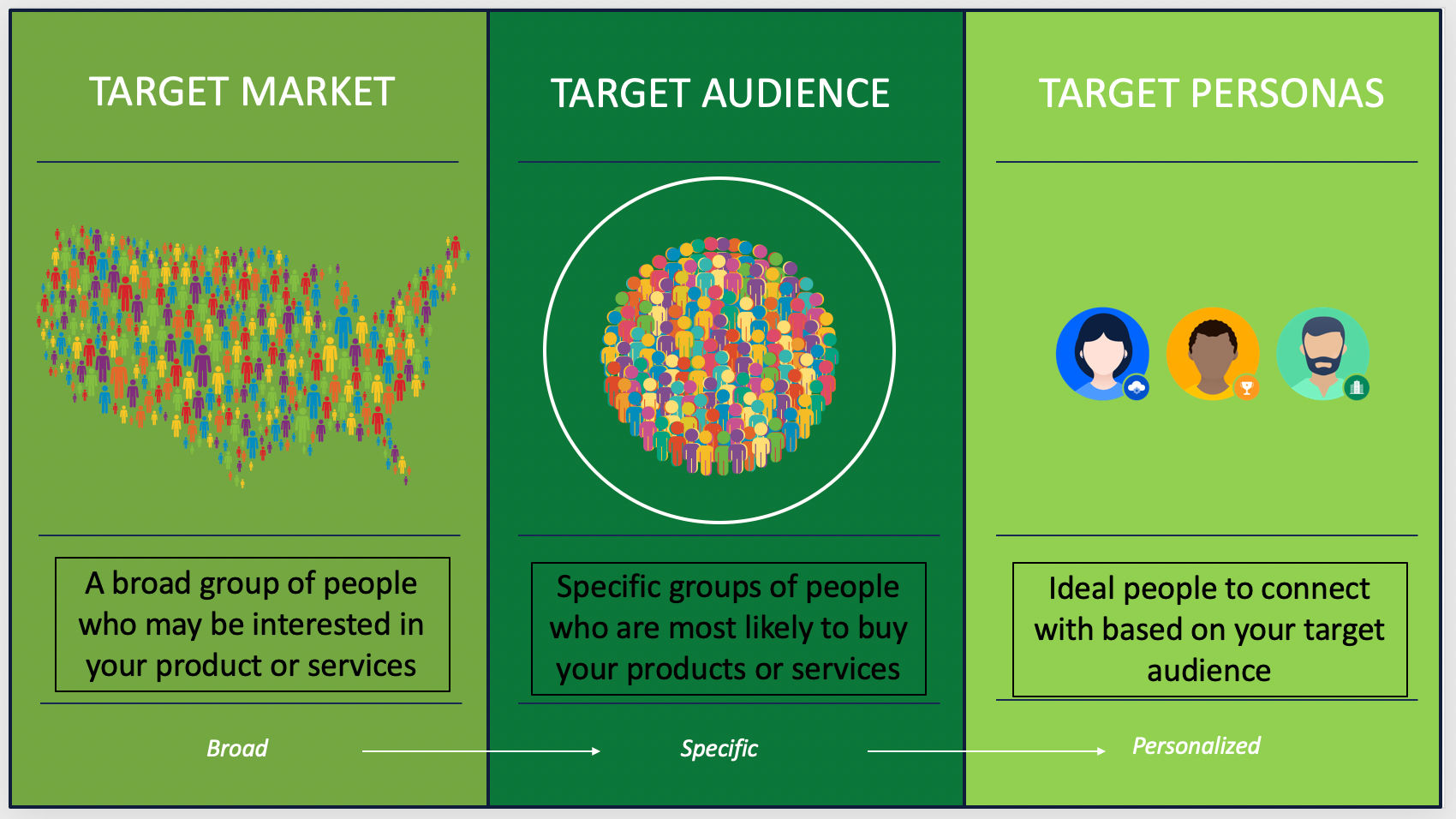
How to find and connect with your target audience
Now that you understand what target audience means, it's time to explore how you can find and engage with them. Here are some actionable steps to help you achieve that:
- Use Google Analytics to learn more about your customers: Dive into Google Analytics to gain insights into your website visitors' demographics, interests, and behavior. Analyse metrics such as age, gender, location, and browsing habits to tailor your marketing efforts accordingly.
- Look at social media analytics: Social media platforms offer valuable insights into your audience's preferences and behaviours. Utilise analytics tools provided by platforms like Facebook, Twitter, and LinkedIn to track engagement metrics, audience demographics, and content performance.
- Check on website performance: Regularly monitor your website's performance metrics, such as traffic sources, bounce rate, and conversion rates. Understanding how visitors interact with your site can help you optimise user experience and tailor your marketing messages to resonate with your audience.
- Engage with social media audiences: Actively engage with your social media audience by responding to comments, messages, and mentions. Encourage conversation, address customer inquiries, and gather feedback to foster meaningful connections and build brand loyalty.
Setting clear goals and objectives
Setting clear and achievable goals is the cornerstone of success when it comes to digital marketing. Without a roadmap outlining your objectives, it's challenging to navigate the vast landscape of online promotion effectively.
To help you embark on this journey with confidence, let's explore the importance of setting clear goals and objectives in digital marketing and uncover the power of specific, measurable, attainable, realistic, and time-based goals.
Why it's important
Clear goals and objectives serve as a compass, guiding decision-making processes, resource allocation, and strategy development. They provide focus and clarity, helping businesses prioritise initiatives and allocate resources effectively. Additionally, well-defined goals enable teams to track progress, measure success, and adapt strategies based on real-time insights.
How to use the SMART framework
The SMART framework is a powerful tool for setting and achieving goals in digital marketing. SMART stands for Specific, Measurable, Achievable, Relevant, and Time-bound. Through this framework, businesses can ensure that their goals are well-defined, actionable, and aligned with their overarching objectives.
- Specific: Goals should be clear, concise, and specific. Instead of setting vague objectives like "increase website traffic," aim for specificity by stating "increase website traffic by 20% in the next quarter."
- Measurable: Goals should be quantifiable and measurable. Establish key performance indicators (KPIs) to track progress and determine success. For instance, track metrics such as website visits, conversion rates, and revenue generated.
- Achievable: Goals should be realistic and attainable within the given resources and constraints. Consider factors such as budget, manpower, and technology infrastructure when setting goals to ensure they are achievable.
- Relevant: Goals should be relevant to the broader business objectives and strategic priorities. Align digital marketing goals with the overall mission, vision, and values of the organisation to ensure coherence and synergy.
- Time-bound: Goals should have a defined timeframe for completion. Set deadlines and milestones to create a sense of urgency and accountability. This ensures that progress is tracked, and actions are taken within a specified timeframe.
Conducting competitor research
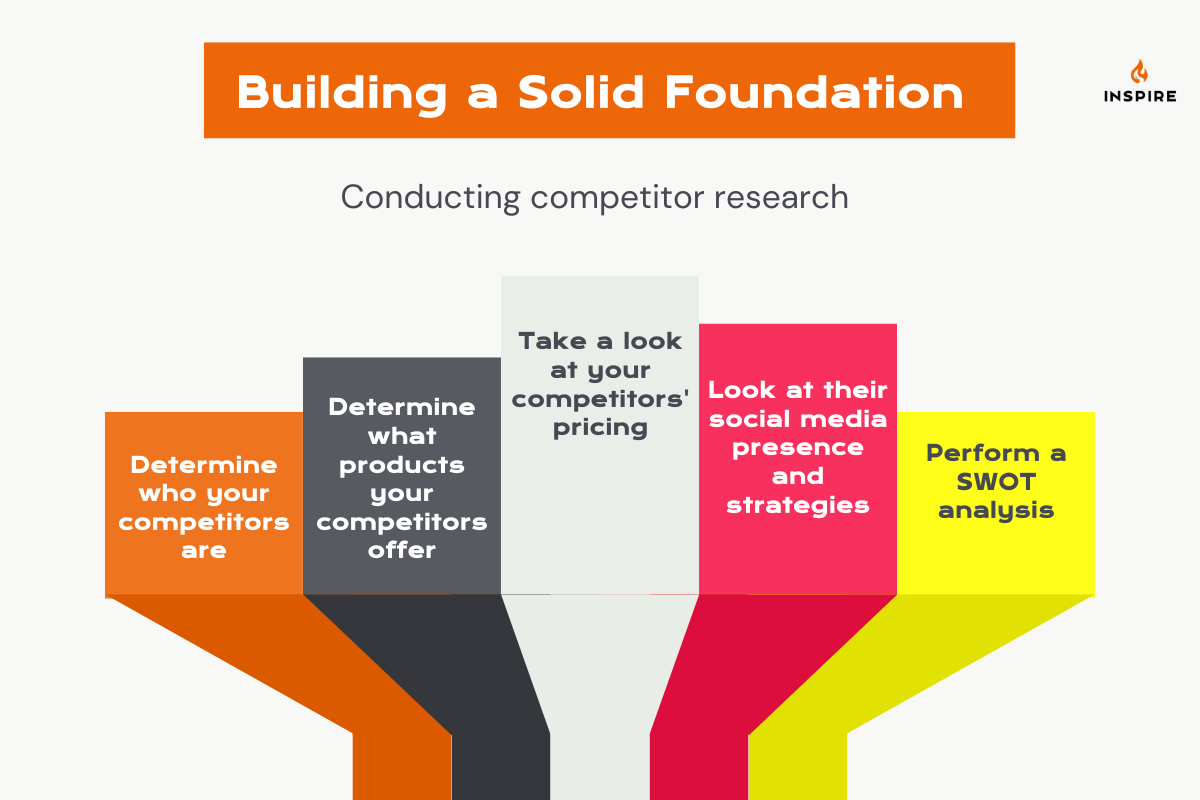
Before starting your digital marketing strategy, it's crucial to understand who else is vying for your audience's attention. This is where competitor research comes into play. Competitor research involves systematically gathering and analysing information about your competitors to gain insights into their strategies, strengths, and weaknesses.
Here's how you can conduct competitive analysis for your business:
- Determine who your competitors are: Start by identifying direct and indirect competitors in your industry. Direct competitors offer similar products or services to the same target audience, while indirect competitors may address the same need or desire through different means.
- Determine what products your competitors offer: Analyse the products or services offered by your competitors. Determine their features, benefits, and unique selling propositions (USPs) to understand how they position themselves in the market.
- Take a look at your competitors' pricing: Evaluate your competitors' pricing strategies to gain insights into their positioning and perceived value. Consider any discounts, promotions, or incentives they offer to attract customers.
- Look at their social media presence and strategies: Examine your competitors' social media presence across various platforms. Analyse their content, engagement levels, and audience demographics to understand their social media strategies and identify opportunities for improvement.
- Perform a SWOT analysis: Conduct a SWOT (Strengths, Weaknesses, Opportunities, Threats) analysis of your competitors to assess their competitive position. Identify their strengths and weaknesses, as well as potential opportunities and threats in the market.
Part 2: Website Development and Design
A professionally designed and developed website is more than just a digital storefront—it's a powerful tool for attracting, engaging, and converting customers. As businesses strive to stand out in a crowded online marketplace, investing in bespoke web development and design has become essential for success.
Importance of bespoke web development
Off-the-shelf website templates may offer convenience, but they lack the flexibility and uniqueness necessary to truly reflect your brand identity and meet your business objectives. Bespoke web development allows businesses to tailor their website to their specific needs, ensuring a seamless user experience, optimal functionality, and enhanced performance.
According to research by Stanford University, 75% of users admit to making judgments about a company's credibility based on their website design, highlighting the importance of investing in custom web development to build trust and credibility with your audience.
Elements of a successful business website

A successful business website goes beyond aesthetics—it's about functionality, usability, and conversion optimisation. Let's explore the elements that makes up a successful business website:
- Intuitive navigation: User should be able to navigate your website effortlessly, finding the information they need without friction. Intuitive navigation involves logical menu structures, clear labels, and consistent design elements that guide users through the site's content hierarchy.
- Clear calls-to-action (CTAs): Every page of your website should have a clear and compelling call-to-action that prompts visitors to take the desired action, whether it's making a purchase, filling out a contact form, or subscribing to your newsletter.
- Responsive design: With the majority of internet users accessing websites on mobile devices, responsive design is non-negotiable. A responsive website adapts seamlessly to various screen sizes and devices, providing a consistent and optimised experience across desktops, laptops, tablets, and smartphones.
- Fast load times: Fast load times are crucial for retaining visitors and minimising bounce rates. Optimising images, leveraging browser caching, and minimising server response times are just a few strategies to enhance website speed.
- Accessibility: A truly inclusive website ensures that users of all abilities can access and interact with its content. This involves adhering to web accessibility standards such as providing alternative text for images, using descriptive link text, and ensuring keyboard navigation functionality.
Custom website design UK
Your website serves as the digital face of your brand, and a one-size-fits-all approach simply won't suffice. Custom website design allows businesses to showcase their unique brand personality, values, and offerings, setting them apart from the competition and leaving a lasting impression on visitors.
By collaborating with a skilled web designer who understands your business goals and target audience, you can create a visually stunning and highly functional website that drives results and supports your growth objectives.
Optimising website speed and user experience
In today's fast-paced digital landscape, users expect instant access to information and seamless browsing experiences. Optimising website speed and user experience is crucial for reducing bounce rates, increasing engagement, and improving search engine rankings.
Studies show that a one-second delay in page load time can lead to a 7% reduction in conversions, emphasising the importance of prioritising speed and performance optimisation in website development and design.
Part 3: Search Engine Optimisation (SEO)
Search Engine Optimisation (SEO) is the process of optimising a website to improve its visibility and ranking in search engine results pages (SERPs). In simple terms, SEO helps businesses increase their online presence and attract more organic (non-paid) traffic from search engines like Google, Bing, and Yahoo.
It plays a critical role in promoting your online business by ensuring that your website appears prominently in search results when potential customers search for relevant keywords or phrases related to your products or services.
How to attract more website traffic and convert them into customers
Increasing your website traffic and converting them into customers is a crucial part for your business growth. Here are some tips you can implement into your marketing strategy:
- Create quality content: Produce high-quality, relevant content that addresses the needs and interests of your target audience. This can include blog posts, articles, videos, infographics, and other engaging formats.
- Utilise social media: Promote your content on social media platforms to reach a wider audience and drive traffic back to your website. Engage with your followers, share valuable content, and participate in relevant conversations to increase brand visibility.
- Run paid advertising campaigns: Invest in paid advertising channels such as Google Ads, social media ads, and display ads to target specific demographics and drive traffic to your website. Monitor and optimise your campaigns to maximise ROI.
- Optimise website performance: Ensure that your website loads quickly, is mobile-friendly, and provides a seamless user experience across all devices. Improve site navigation, optimise landing pages, and remove any barriers that may hinder conversion.
- Capture and nurture leads: Implement lead capture forms, pop-ups, and calls-to-action (CTAs) strategically throughout your website to capture visitor information. Use email marketing and marketing automation to nurture leads and guide them through the sales funnel.
- Track and analyse data: Use web analytics tools such as Google Analytics to track website traffic, user behaviour, and conversion metrics. Analyse data to identify areas for improvement and optimise your strategies for better results.
Importance of SEO services UK
Having a strong online presence is essential for business success. Here's why incorporating SEO is important in your digital marketing strategy:
- Enhanced visibility: SEO services help businesses rank higher in search engine results pages (SERPs), making it easier for potential customers to find them online. By optimising website content and structure, businesses can increase their visibility and reach a wider audience.
- Increased website traffic:Organic searches make up 53% of all website traffic. With SEO, businesses can attract quality traffic from users actively searching for products or services related to their industry, resulting in higher conversion rates and revenue.
- Better user experience: SEO involves improving website performance, improving site speed, and enhancing user experience. By providing users with a seamless and intuitive browsing experience, businesses can increase engagement, reduce bounce rates, and foster customer loyalty.
- Competitive advantage: In today's competitive marketplace, businesses that invest in SEO gain a competitive edge. By outranking competitors in search results, businesses can establish themselves as industry leaders and attract more customers.
- Long-term results: With ongoing optimisation and maintenance, businesses can maintain their search engine rankings and continue to reap the rewards of increased visibility and traffic.
Conducting keyword research
Keyword research is the cornerstone of any successful SEO strategy, guiding businesses in understanding their audience's search behaviour and optimising their content accordingly. By identifying relevant keywords and phrases, businesses can enhance their visibility in search engine results and attract qualified traffic to their website.
- Identifying broad topics: Start by brainstorming broad topics relevant to your business or industry. These topics serve as the foundation for your keyword research and help you understand the overarching themes your audience is interested in.
- Expanding topic lists: Once you have your broad topics, delve deeper into each one by creating a list of phrases and terms that your customers are likely to use when searching for information related to those topics. These phrases provide valuable insight into the language your audience uses and the specific terms they search for.
- Finding related search terms: Use keyword research tools to uncover related search terms and variations of your primary keywords. This allows you to capture a broader range of search queries and identify additional opportunities to target your audience.
- Analysing keyword strength: Assess the strength of your chosen keywords by evaluating factors such as search volume, competition, and relevance to your business. Focus on targeting keywords with a balance of high search volume and manageable competition to maximise your visibility.
- Verifying search intent: Finally, verify that the keywords you've chosen align with the search intent of your target audience. Ensure that your content addresses the needs and questions of users searching for those keywords to improve engagement and conversion rates.
On-page optimisation techniques
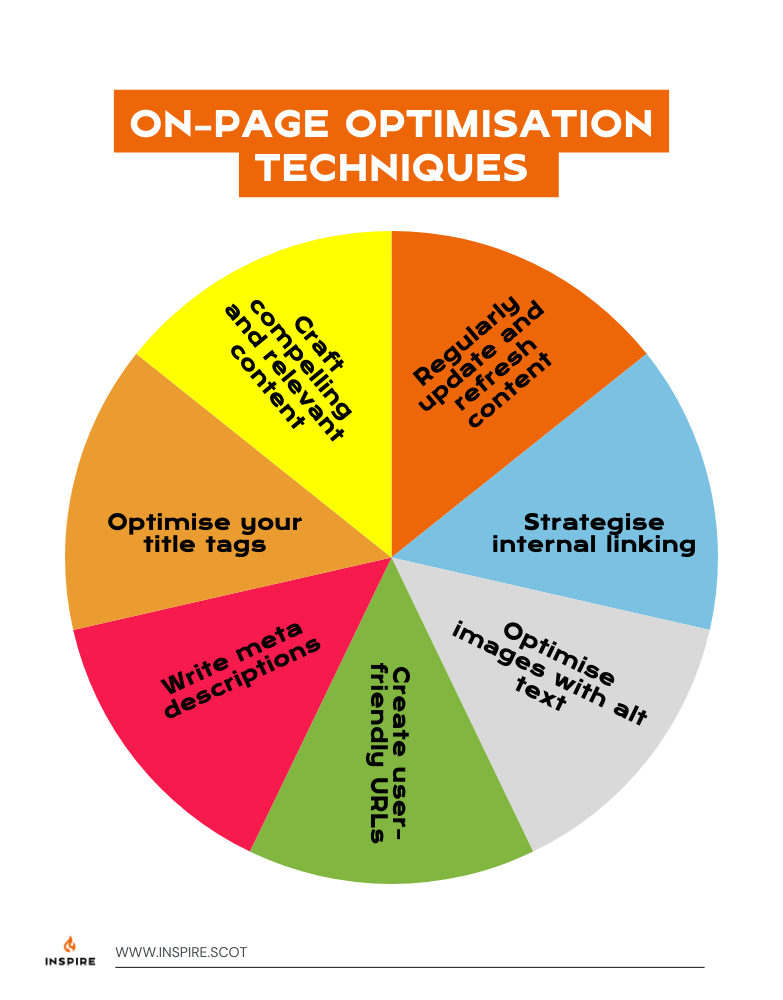
On-page SEO, also referred to as on-site SEO, is the process of optimising both front-end and back-end aspects of your website so that it performs better in search rankings. It matters because it holds essential information to Google about your website and how it adds value for visitors and customers. This optimisation ensures your site is geared for both human users and search engine crawlers.
Here's how you can effectively optimise your website:
- Craft compelling and relevant content: Your content is the backbone of on-page SEO. Create engaging, informative, and relevant content that resonates with your audience. Remember to use language that your visitors understand, and naturally integrate keywords without compromising readability.
- Optimise your title tags: Title tags act as the headline for your page in search results. Make them catchy, concise, and reflective of the content within. Don't forget to include relevant keywords naturally to boost visibility.
- Meta descriptions: Craft enticing meta descriptions that provide a brief overview of your page. While meta descriptions may not directly impact rankings, they influence click-through rates, making them an essential aspect of on-page SEO.
- User-Friendly URLs: Ensure your URLs are clear, concise, and user-friendly. A well-structured URL not only aids search engines in understanding your page but also makes it easier for visitors to navigate.
- Optimise images with alt text: Describe your images using alt text. Not only does this improve accessibility, but it also provides search engines with information about the content of your images, contributing to overall on-page SEO.
- Internal linking strategy: Implement a thoughtful internal linking strategy. Link relevant pages within your website to enhance navigation and distribute link equity, contributing to improved search engine rankings.
- Regularly update and refresh content: Keep your content up-to-date and relevant. Regularly updating your pages signals to search engines that your website is active and authoritative, potentially boosting your rankings.
Off-page optimisation strategies for higher rankings
Off-page optimisation plays a crucial role in boosting your website's search engine rankings and increasing its online visibility. By implementing effective off-page strategies, businesses can enhance their authority, credibility, and relevance in the eyes of search engines, ultimately driving more traffic to their site.
- Harnessing the power of link building: Link building remains one of the most influential off-page optimisation techniques. By acquiring high-quality backlinks from reputable websites, businesses can signal to search engines that their content is valuable and authoritative.
- Leveraging social media marketing: Social media platforms offer a powerful avenue for amplifying your online presence and driving traffic to your website. By actively engaging with your audience on platforms like Facebook, Twitter, and LinkedIn, businesses can increase brand awareness, foster community engagement, and attract potential customers.
- Engaging in influencer outreach: Collaborating with influencers in your industry can significantly impact your off-page optimisation efforts. Identify influencers who resonate with your target audience and collaborate with them to promote your content, products, or services.
Part 4: Harnessing the Power of Social Media
Social media has become an indispensable tool for businesses looking to expand their online presence, engage with their audience, and drive conversions. With billions of active users across various platforms, social media offers unparalleled opportunities for brand visibility and customer interaction.
Here's how you can leverage social media advertising to promote your business effectively:
How can I use social media to promote my business?
Social media offers a multitude of ways to promote your business, from sharing valuable content and running targeted ad campaigns to engaging with your audience through comments, messages, and live chats. By establishing a strong presence on platforms relevant to your industry and audience demographics, you can reach potential customers where they spend their time online.
Social media marketing tips for businesses
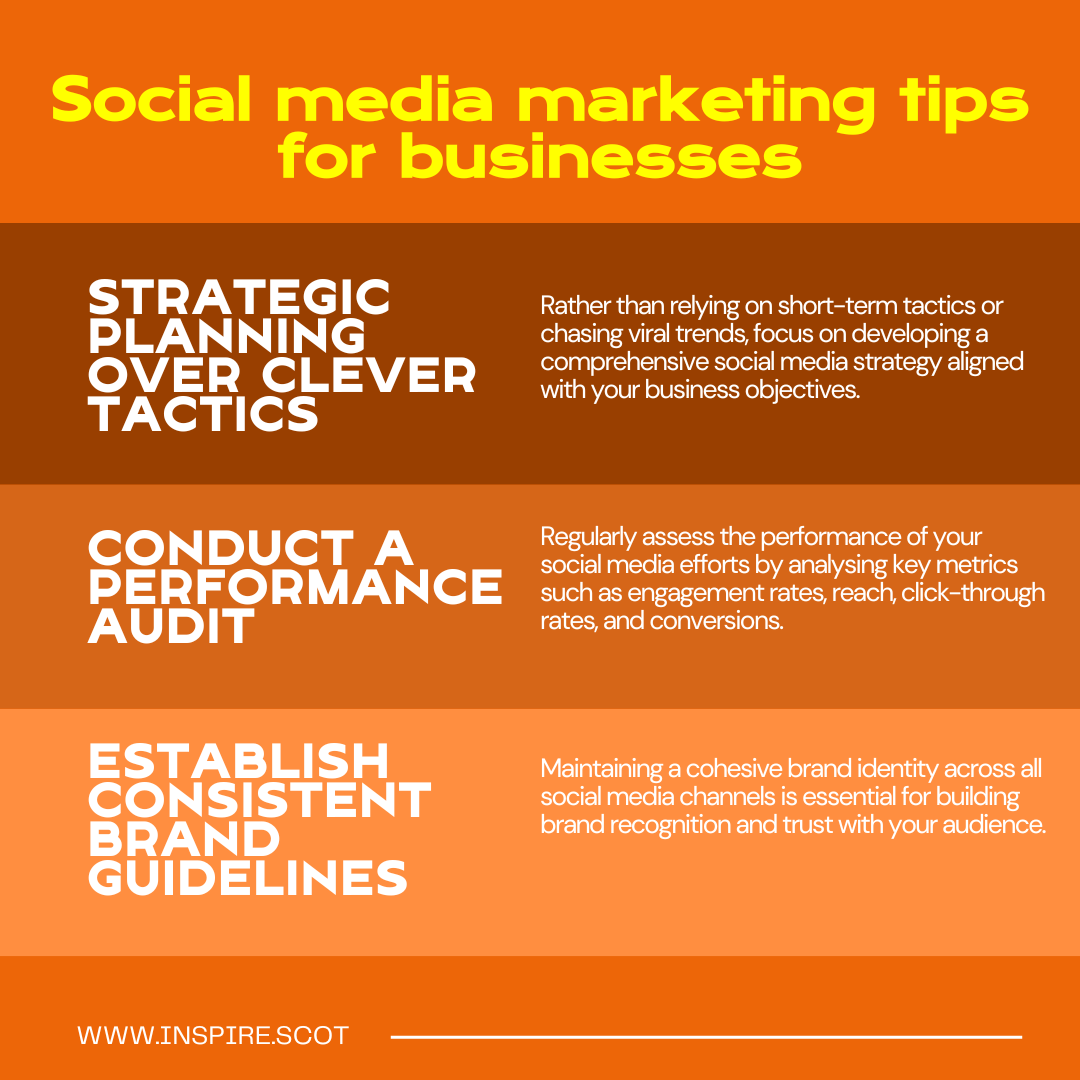
Effective social media marketing goes beyond posting random content and hoping for the best. It requires strategic planning, data-driven decision-making, and consistent branding to achieve meaningful results. Here are some essential tips to elevate your social media marketing efforts:
- Strategic planning over clever tactics: Rather than relying on short-term tactics or chasing viral trends, focus on developing a comprehensive social media strategy aligned with your business objectives. Define your target audience, set clear goals, and outline tactics to achieve them.
- Conduct a performance audit: Regularly assess the performance of your social media efforts by analysing key metrics such as engagement rates, reach, click-through rates, and conversions. Use analytics tools provided by social networks or third-party tools to track your performance over time and identify areas for improvement.
- Establish consistent brand guidelines: Maintaining a cohesive brand identity across all social media channels is essential for building brand recognition and trust with your audience. Develop clear brand guidelines that dictate your brand voice, visual style, messaging tone, and content themes. Ensure that your branding elements, such as logos, color schemes, and typography, remain consistent across all posts and platforms.
Choosing the right platforms for your target audience
Not all social media sites are created equal, and it's crucial to select the ones that align with your target audience's preferences and behaviors. Conduct market research to identify which platforms your audience frequents most and focus your efforts on building a presence there. Whether it's Facebook, Instagram, LinkedIn, Twitter, or TikTok, each platform offers unique features and demographics that can influence your marketing approach.
Creating engaging content for social media
Content is king in the realm of social media, and creating compelling, visually appealing content is key to capturing your audience's attention and driving engagement. Experiment with different content formats such as videos, images, infographics, and polls to keep your feed diverse and engaging. Tailor your content to resonate with your audience's interests, pain points, and aspirations, and don't forget to incorporate relevant hashtags and keywords to enhance discoverability.
Building and engaging with your online community
Building a loyal online community is essential for fostering brand advocacy and driving word-of-mouth referrals. Encourage two-way communication by responding promptly to comments, messages, and mentions, and actively participate in industry-related conversations and trending topics. Hosting interactive Q&A sessions, contests, and live events can further strengthen your community bonds and deepen customer relationships.
Part 5: Pay-Per-Click (PPC) Advertising
Pay-Per-Click (PPC) advertising remains a powerful tool for businesses to reach their target audience and drive conversions. By understanding the fundamentals of PPC advertising and implementing strategic campaigns, businesses can effectively boost their online visibility and achieve tangible results.
Here's a breakdown of essential aspects to consider when delving into PPC advertising:
Understanding the basics of PPC advertising
PPC advertising allows businesses to bid on keywords relevant to their products or services and place ads on search engine results pages (SERPs) or other online platforms. Unlike traditional advertising models, PPC campaigns operate on a pay-per-click basis, where advertisers only pay when users click on their ads. Understanding the mechanics of keyword bidding, ad placement, and budget management is crucial for success in PPC advertising.
Creating effective ad campaigns
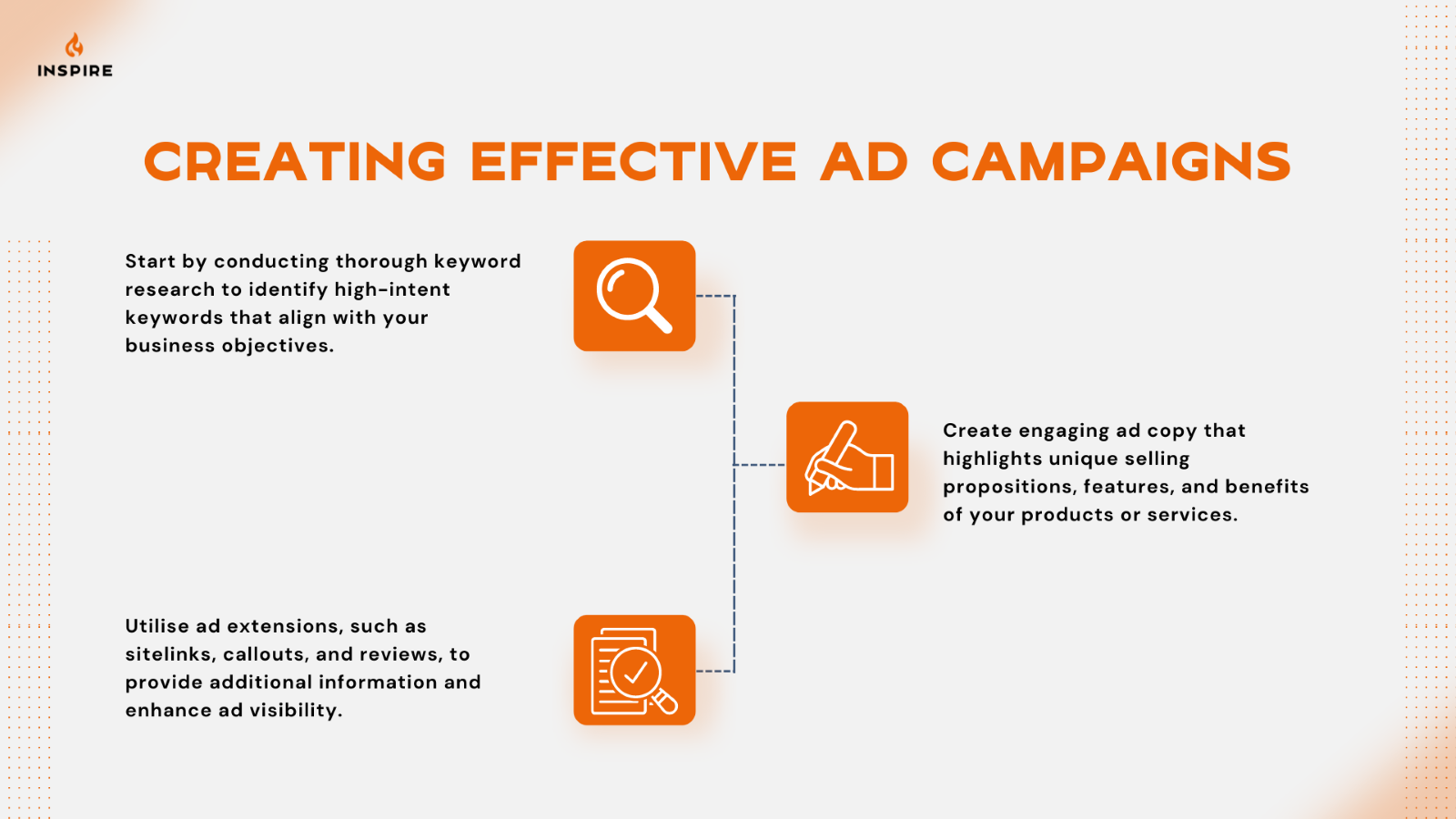
Crafting compelling ad campaigns is essential for capturing the attention of your target audience and driving clicks to your website. Here's how you can create engaging and effective ads:
- Start by conducting thorough keyword research to identify high-intent keywords that align with your business objectives.
- Create engaging ad copy that highlights unique selling propositions, features, and benefits of your products or services.
- Utilise ad extensions, such as sitelinks, callouts, and reviews, to provide additional information and enhance ad visibility.
Monitoring and optimising PPC campaigns
Continuous monitoring and optimisation are key to maximising the performance of your PPC campaigns. Regularly review key performance metrics, such as click-through rate (CTR), conversion rate, cost per click (CPC), and return on ad spend (ROAS), to gauge the effectiveness of your campaigns. Identify underperforming keywords, ad groups, or targeting settings and make data-driven adjustments to improve campaign performance and ROI.
Maximising ROI with conversion tracking
Implementing conversion tracking is essential for measuring the effectiveness of your PPC campaigns and optimising for maximum return on investment (ROI). Set up conversion tracking pixels or tags on your website to track specific actions taken by users, such as form submissions, purchases, or newsletter sign-ups.
Analyse conversion data to identify high-performing keywords, ads, and landing pages, and allocate budget towards campaigns that drive the most valuable actions for your business.
Part 6: Content Marketing and Copywriting
Content marketing and copywriting play integral roles in shaping a brand's online presence and driving customer engagement. By leveraging compelling content and strategic copywriting, businesses can effectively communicate their brand story, connect with their target audience, and achieve their marketing objectives.
Here's a closer look at how content marketing and copywriting can elevate your brand:
Importance of effective copywriting for businesses
Effective copywriting is the foundation of successful marketing campaigns, as it influences how customers perceive and interact with your brand. From website copy and blog posts to social media captions and email newsletters, every piece of written content should be crafted with precision and purpose.
Compelling copywriting can captivate audiences, evoke emotions, and compel action, ultimately driving conversions and fostering brand loyalty.
How can I leverage content marketing to increase brand awareness and engagement?
Content marketing offers businesses a powerful platform to increase brand visibility, attract qualified leads, and foster meaningful relationships with customers. By creating valuable and relevant content that addresses the needs and interests of your target audience, you can establish your brand as a trusted authority in your industry and drive engagement across various channels. Whether it's informative blog posts, entertaining videos, or interactive infographics, engaging content can help you connect with your audience on a deeper level and drive positive brand interactions.
Creating valuable and engaging content
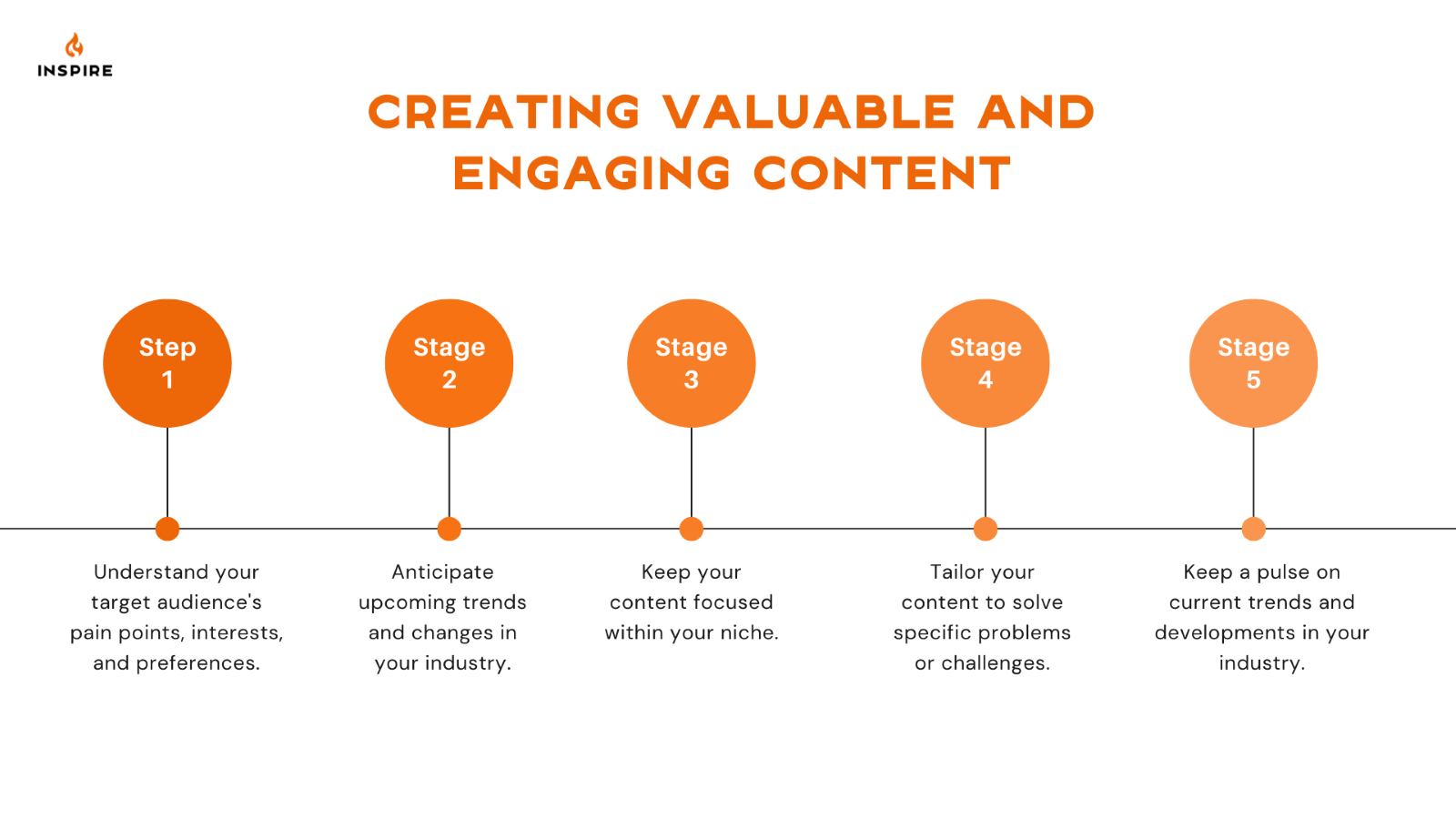
The key to successful content marketing lies in creating content that resonates with your audience and provides genuine value. Here is a quick guide to help you create quality content:
- Start by understanding your target audience's pain points, interests, and preferences, and tailor your content to address their needs and aspirations.
- Anticipate upcoming trends and changes in your industry to stay ahead of the curve and adapt your content strategy accordingly.
- Keep your content focused within your niche to establish authority and attract the right audience who are genuinely interested in what you have to offer.
- Tailor your content to solve specific problems or challenges faced by your target audience, providing them with valuable solutions and insights.
- Keep a pulse on current trends and developments in your industry to ensure your content remains relevant and engaging to your audience.
Optimising content for search engines
Optimising your content for search engines is crucial for improving your online visibility and driving organic traffic to your website. By implementing strategic SEO techniques, you can ensure that your content ranks well in search engine results pages (SERPs) and attracts relevant visitors.
Here are some key strategies to optimise your content for search engines:
- Keep user intent top-of-mind: Understand the intent behind your target audience's search queries and tailor your content to meet their needs. Whether they're seeking information, looking to make a purchase, or seeking a solution to a problem, align your content with their intent to provide valuable and relevant answers.
- Write for quality—not quantity: Focus on creating high-quality content that provides value to your audience and addresses their specific needs and interests. Aim for depth, relevance, and originality in your content, rather than prioritising word count.
- Be strategic about your headingss Organise your content with clear and hierarchical headings that guide readers through your page. Use heading tags (H1, H2, H3, etc.) to structure your content logically and emphasise key points. Incorporate relevant keywords into your headings to signal to search engines the main topics covered in your content.
Using content marketing to establish authority and brand awareness
Content marketing provides businesses with a unique opportunity to showcase their expertise, build credibility, and differentiate themselves from competitors. By consistently publishing high-quality content that addresses industry trends, challenges, and innovations, you can position your brand as a thought leader and trusted resource within your niche. Share your content across multiple channels, engage with your audience, and encourage social sharing to amplify your brand's reach and visibility.
Part 7: Building Backlinks
Backlinks are essential components of SEO that play a significant role in determining the authority and credibility of your website in the eyes of search engines. They serve as endorsements from other websites, indicating to search engines that your content is valuable and worthy of reference.
In this section, we'll explore the importance of backlinks in SEO and provide actionable strategies for earning and managing high-quality backlinks.
Importance of backlinks in SEO
Backlinks serve as valuable signals to search engines, indicating the relevance, credibility, and authority of your website. They play a crucial role in improving your website's visibility and rankings in search engine results pages (SERPs). Websites with a diverse portfolio of high-quality backlinks are more likely to rank higher in search results, attract organic traffic, and establish trust with both users and search engines.
Strategies for earning high-quality backlinks
Building a strong backlink profile is essential for improving your website's visibility and authority in search engine results. From creating valuable and shareable content to fostering relationships with industry influencers, we'll explore actionable techniques to attract valuable backlinks that can enhance your SEO efforts and drive organic traffic to your website.
- Create high-quality content: Develop informative, engaging, and shareable content that naturally attracts backlinks from other websites seeking valuable resources.
- Build relationships with influencers: Cultivate relationships with industry influencers and thought leaders in your niche. Collaborate on content, guest blogging opportunities, or joint ventures to earn authoritative backlinks from reputable sources.
- Guest blogging: Contribute guest posts to authoritative websites and blogs within your industry. Ensure that your guest posts provide valuable insights and information while including relevant backlinks to your own website.
- Broken link building: Identify broken links on authoritative websites and offer to replace them with relevant content from your own website. This mutually beneficial strategy helps you earn backlinks while assisting website owners in maintaining their site's integrity.
- Content promotion and outreach: Actively promote your content through social media accounts, email outreach, and industry forums to increase its visibility and attract organic backlinks from interested parties.
Guest blogging and influencer outreach techniques
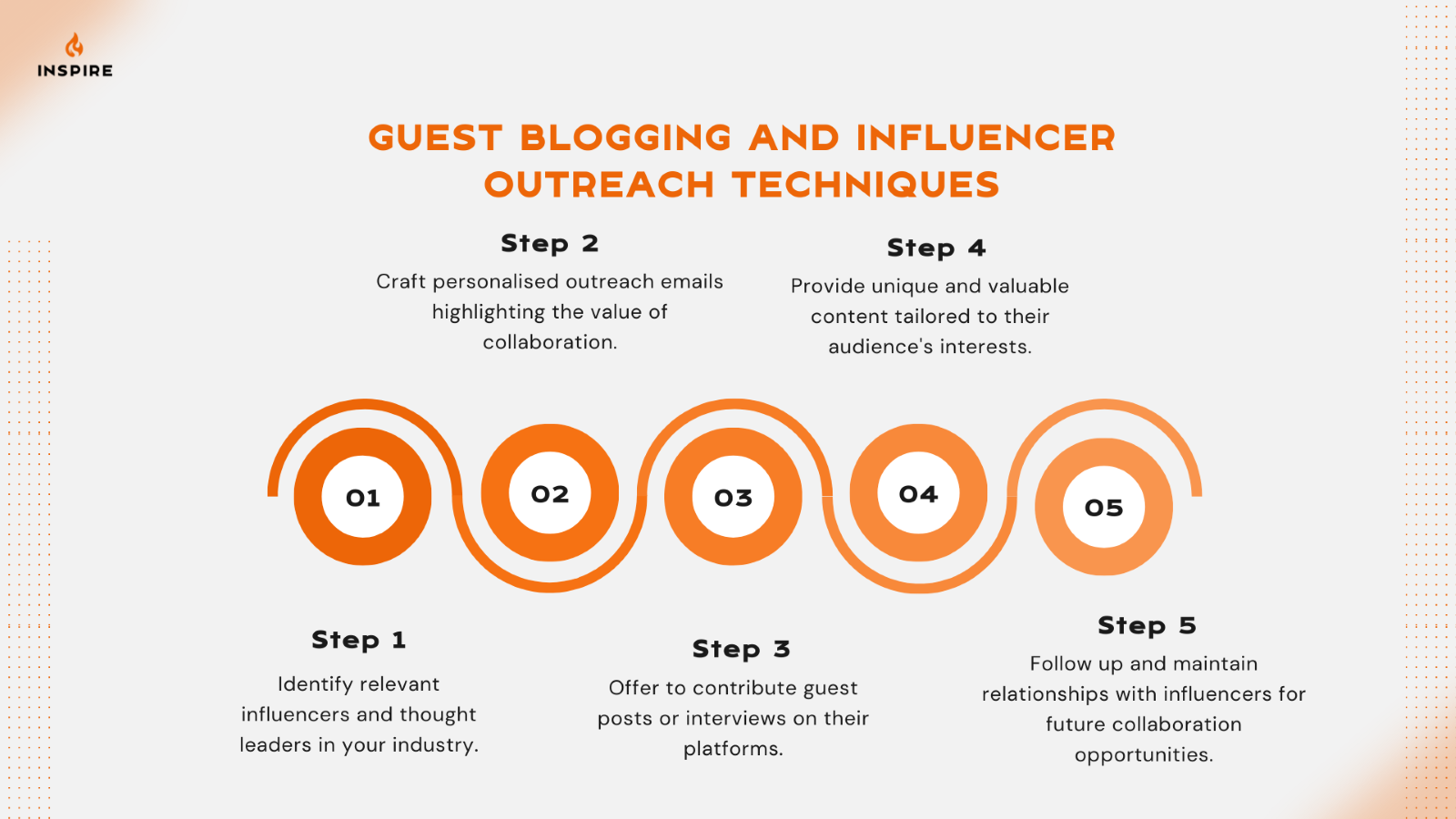
Guest blogging and influencer outreach are powerful strategies for acquiring high-quality backlinks and expanding your online presence. Let's delve into the effective techniques for establishing relationships with influencers, contributing guest posts to authoritative websites, and leveraging these opportunities to earn valuable backlinks for your website.
-
Identify relevant influencers and thought leaders in your industry.
-
Craft personalised outreach emails highlighting the value of collaboration.
-
Offer to contribute guest posts or interviews on their platforms.
-
Provide unique and valuable content tailored to their audience's interests.
-
Follow up and maintain relationships with influencers for future collaboration opportunities.
Monitoring and managing your backlink profile
Monitoring and managing your backlink profile is crucial for maintaining the health and effectiveness of your SEO efforts. Let's discuss the importance of regularly monitoring your backlinks, identifying potential issues such as spammy or low-quality links, and implementing strategies to effectively manage and optimise your backlink profile for improved search engine rankings and organic traffic.
- Utilise tools like Google Search Console, Ahrefs, or Moz to monitor your backlink profile regularly.
- Identify and disavow low-quality or spammy backlinks that may harm your website's SEO.
- Monitor changes in your backlink profile and investigate any unexpected fluctuations.
- Continuously audit and update your backlink strategy to maintain a healthy and diverse link profile.
Part 8: Email Marketing
As the digital landscape becomes more competitive, businesses are continually seeking innovative ways to expand their online presence and connect with their target audience. Enter email marketing – a dynamic and versatile strategy that has stood the test of time as a cornerstone of successful online promotion.
What are the benefits of using email marketing to promote my business online?
Email marketing offers a myriad of benefits that make it an indispensable tool for businesses of all sizes and industries. Let's explore why an effective email campaigns can step up your online promotion efforts:
- Direct and personalised communication: From tailored messages addressing individual preferences to targeted promotions based on past interactions, email marketing allows for highly customised communication that resonates with your recipients.
- Cost-effective and high ROI: Compared to traditional marketing channels, email marketing offers exceptional value for money. Based on reports, you can expect a $40 return on investment for every dollar you spent on email marketing.
- Wide reach and audience engagement: With billions of active email users worldwide, email marketing provides businesses with a vast and engaged audience to connect with. Whether you're looking to reach existing customers or attract new prospects, email campaigns offer a powerful platform for engaging with your target audience and driving meaningful interactions.
- Measurable results and performance racking: From open rates and click-through rates to conversion metrics and subscriber engagement, businesses can track and analyse the performance of their email campaigns with precision, allowing for data-driven decision-making and continuous optimisation.
Building a targeted email list
A successful email marketing strategy involves a targeted email list. By curating a list of engaged subscribers who are genuinely interested in your products or services, you can create more meaningful connections and drive higher engagement rates. Let's check out some ways on how you can build and expand your email list with qualified leads and potential customers:
- Opt-in forms: Embed opt-in forms on your website and landing pages to capture email addresses from visitors who express interest in your products or services.
- Content upgrades: Offer valuable content upgrades such as e-books, guides, or exclusive content in exchange for email subscriptions, enticing visitors to join your email list.
- Social media integration: Promote your email newsletter on social media networks and encourage followers to subscribe for updates and exclusive offers.
- Networking Events: Collect email addresses from attendees at networking events, conferences, or trade shows to expand your email list with qualified leads.
Designing compelling email campaigns
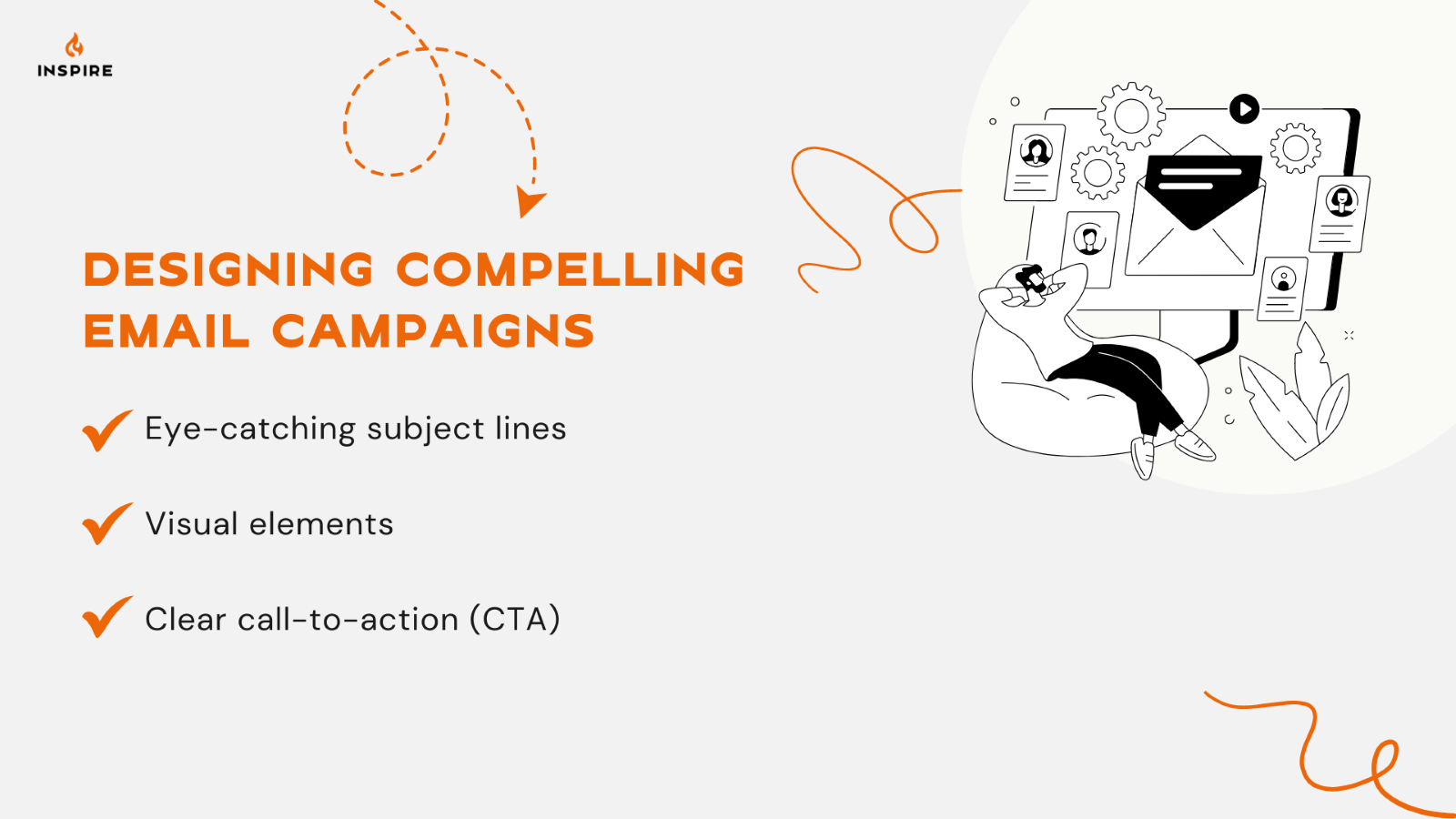
Designing compelling email campaigns is essential for capturing the attention of your audience and driving action. In this section, we'll discuss strategies for creating visually appealing and engaging email campaigns that resonate with your subscribers and inspire them to take action.
- Eye-catching subject lines: Create compelling subject lines that pique curiosity and encourage recipients to open your emails.
- Visual elements: Incorporate high-quality images, graphics, and videos to enhance the visual appeal of your emails and convey your message effectively.
- Clear call-to-action (CTA): Include a prominent and persuasive call-to-action (CTA) that directs recipients to take the desired action, whether it's making a purchase, signing up for an event, or downloading a resource.
Personalisation and segmentation strategies
Personalisation and segmentation are key components of effective email marketing, allowing you to deliver targeted and relevant content to your subscribers. Let's discuss advanced personalisation and segmentation strategies to maximise the impact of your email campaigns:
- Dynamic content: Personalise email content based on recipient demographics, interests, and past interactions to deliver tailored messaging that resonates with individual subscribers.
- Segmentation: Divide your email list into segments based on factors such as demographics, purchase history, or engagement level, allowing for targeted and relevant communication.
- Behavioural triggers: Implement automated email workflows triggered by specific user actions, such as abandoned cart reminders or post-purchase follow-ups, to deliver timely and relevant messages.
Analysing email campaign performance
Analysing email campaign performance is essential for measuring the effectiveness of your email marketing efforts and identifying areas for improvement. By tracking key metrics such as open rates, click-through rates, and conversion rates, you can gain valuable insights into how your campaigns are performing and make data-driven decisions to optimise your future email marketing strategies.
Part 9: Video Marketing
Video marketing has emerged as a powerful tool for businesses to connect with their audience, convey their message, and drive engagement. With the rise of social media and the increasing popularity of video content, consumers are turning to videos to discover products, learn more about brands, and make purchasing decisions.
Creating engaging and shareable video content
Creating engaging and shareable video content is essential for capturing the attention of your audience and encouraging them to take action. Let's check out the strategies for creating videos that resonate with your audience and inspire them to share your content with their networks, amplifying your reach and driving organic growth:
- Tell a story with your video: Storytelling is a powerful technique for creating engaging and shareable video content. By crafting a narrative that resonates with your audience, you can capture their attention and keep them invested in your message.
- Evoke emotion: By tapping into the power of emotion, you can create videos that resonate deeply with your viewers, leaving a lasting impression and prompting them to share your content with others.
- Use stunning visuals:Stunning visuals are essential for capturing the attention of your audience and making your videos stand out. Whether it's vibrant colors, captivating animations, or breathtaking landscapes, visually compelling content can captivate viewers and draw them into your story.
Optimising videos for search engines and social media
Optimising videos for search engines and social feeds is key to ensuring that your content is discoverable and reaches the right audience. By implementing SEO best practices and optimising your video metadata, you can improve your visibility in search results and attract more viewers to your videos. Additionally, by tailoring your videos to each social media platform's unique requirements and algorithms, you can maximise engagement and drive more traffic to your website or landing pages.
Leveraging video platforms for maximum reach
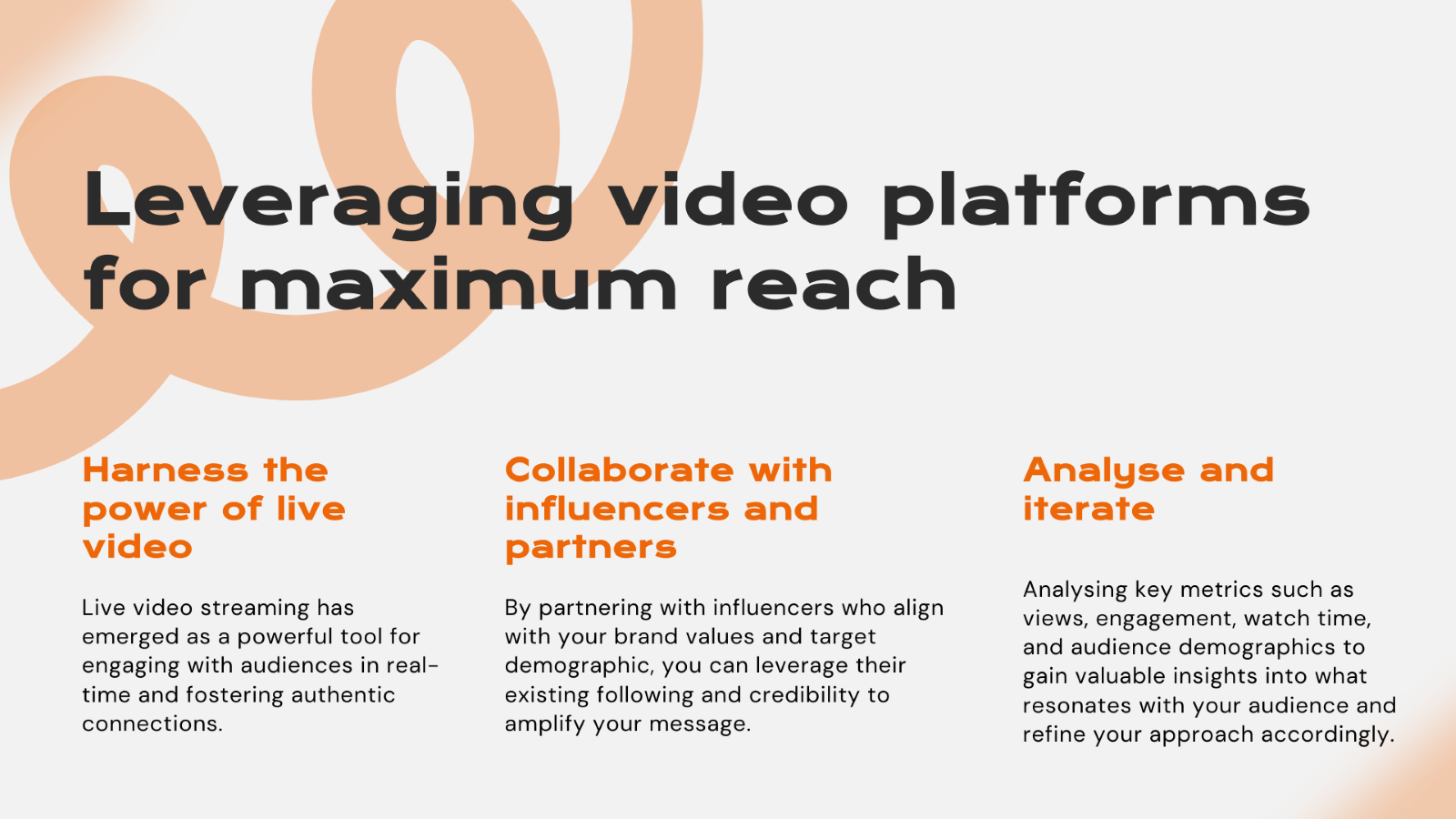
Video platforms offer unparalleled opportunities for reaching a vast audience and maximising the impact of your video content. By strategically leveraging these platforms, you can amplify your reach, engage with your target audience, and drive meaningful results for your business.
- Harness the power of live video: Live video streaming has emerged as a powerful tool for engaging with audiences in real-time and fostering authentic connections. Platforms like Facebook Live, Instagram Live, and YouTube Live enable brands to interact with their followers, answer questions, and provide behind-the-scenes insights.
- Collaborate with influencers and partners: By partnering with influencers who align with your brand values and target demographic, you can leverage their existing following and credibility to amplify your message. Whether it's through sponsored content, co-created videos, or guest appearances, influencer partnerships can help you tap into new markets and drive engagement with your video content.
- Analyse and iterate: Analysing key metrics such as views, engagement, watch time, and audience demographics to gain valuable insights into what resonates with your audience and refine your approach accordingly. Experimenting with different formats, topics, and distribution strategies allows you to continually improve your video content and achieve greater success on video platforms.
Part 10: Measuring and Analysing Results
Understanding the effectiveness of your online marketing efforts is crucial for making informed decisions and optimising your promotional strategies. By employing robust measurement and analysis techniques, you can gain valuable insights into your campaign performance, identify areas for improvement, and drive better results for your business.
How can I measure the success of my online marketing efforts?
Measuring the success of your online marketing efforts requires tracking and analysing various metrics that align with your business objectives. Key performance indicators (KPIs) such as website traffic, conversion rates, engagement metrics, and return on investment (ROI) can provide valuable insights into the effectiveness of your campaigns.
By setting clear goals and benchmarks, you can assess your performance and determine whether your efforts are delivering the desired outcomes.
Tools for tracking and analysing website performance
Numerous tools and analytics platforms are available to help you track and analyse website performance effectively. From Google Analytics and Adobe Analytics to HubSpot and SEMrush, these tools offer valuable insights into user behaviour, traffic sources, conversion funnels, and more.
By leveraging these tools' capabilities, you can gain a deeper understanding of your audience, identify areas for improvement, and optimise your website for better performance.
Key metrics to monitor for online promotion
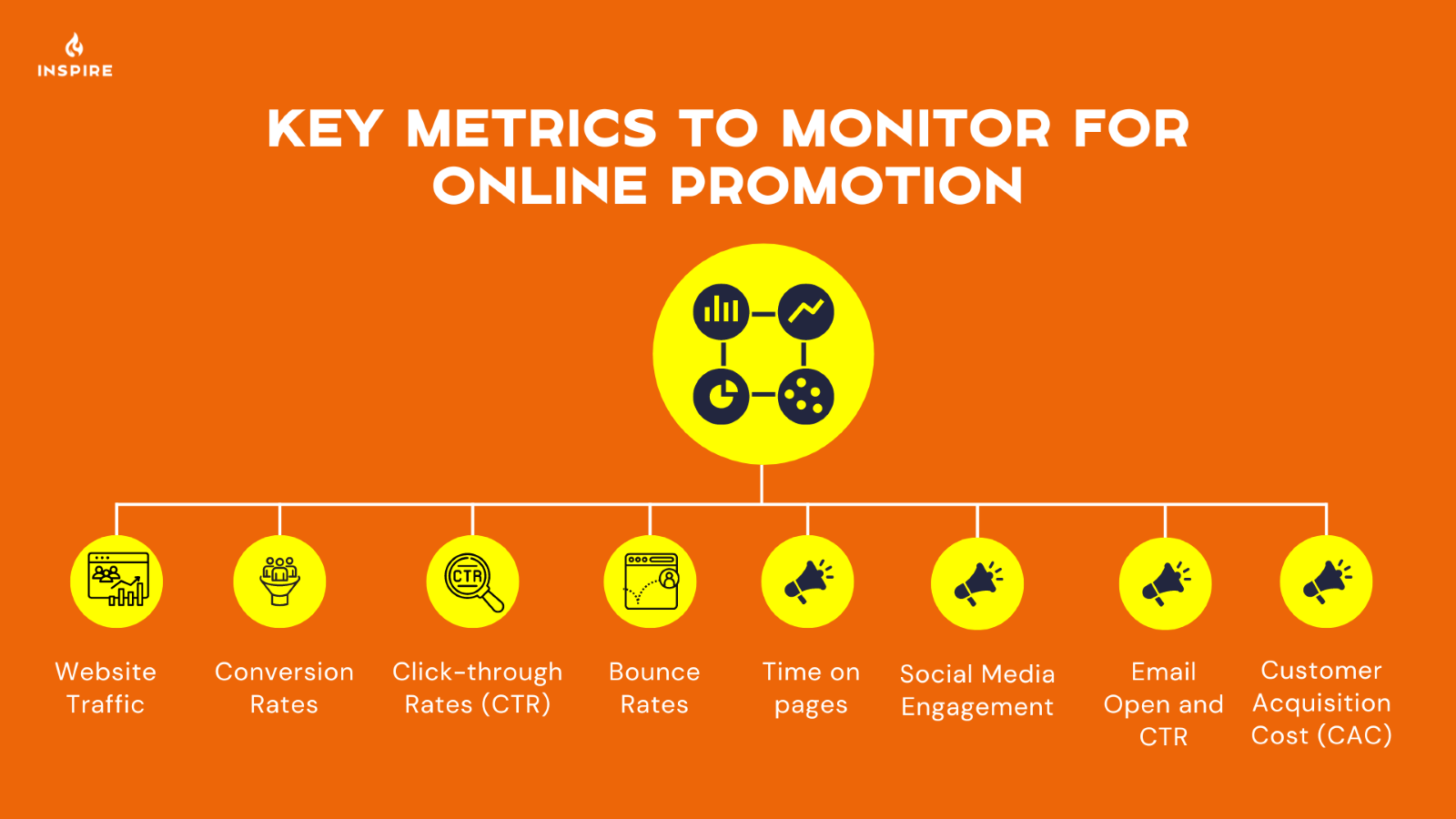
When evaluating the success of your online promotion efforts, several key metrics warrant close attention. These include website traffic, conversion rates, click-through rates (CTR), bounce rates, time on page, social media engagement, email open and click-through rates, and customer acquisition cost (CAC).
By monitoring these metrics regularly, you can gauge the effectiveness of your promotional activities, identify trends, and make data-driven decisions to enhance your marketing strategy.
Making data-driven decisions for optimisation
Data-driven decision-making lies at the heart of successful online promotion. By analysing the insights gleaned from your tracking and analytics efforts, you can identify patterns, trends, and areas of opportunity. Whether it's refining your target audience segments, adjusting your messaging, or reallocating budget to high-performing channels, leveraging data allows you to optimise your promotional efforts for maximum impact and ROI.
By continually monitoring and analysing your results, you can iterate on your strategy, refine your tactics, and drive continuous improvement in your online marketing initiatives.
Conclusion
In the rapidly evolving landscape of digital marketing, staying updated with the latest trends and technologies is paramount to maintaining a competitive edge and driving
meaningful results for your business. As consumer behaviours, preferences, and technology continue to evolve, businesses must adapt their strategies accordingly to remain relevant and effectively engage their target audience.
As digital marketing experts, we at Inspire Digital are committed to helping businesses navigate the ever-changing digital landscape and achieve their marketing objectives. Whether you're looking to harness the power of AI, leverage video marketing, or optimise your online promotion efforts, our team is here to provide expert guidance, innovative solutions, and actionable insights tailored to your unique needs.

Ready to take your digital marketing efforts to the next level?
Contact Inspire Digital today to learn how we can help you stay ahead of the curve, drive measurable results, and propel your business to success in the dynamic world of online promotion. Reach out to us for a personalised consultation and discover the possibilities awaiting your business in the digital realm!

































